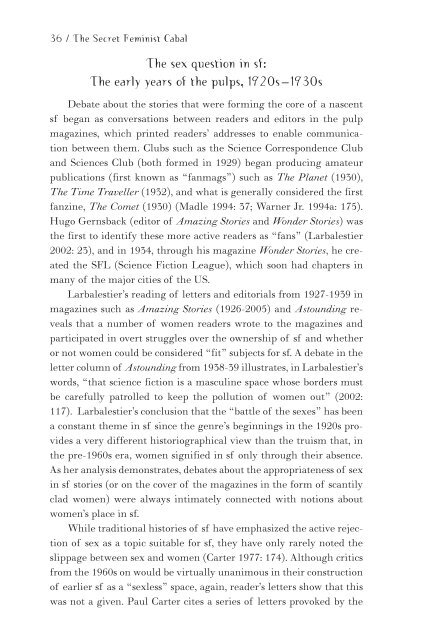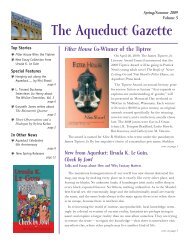Feminist Ca
Read Chapters Two and Three - Aqueduct Press
Read Chapters Two and Three - Aqueduct Press
- No tags were found...
Create successful ePaper yourself
Turn your PDF publications into a flip-book with our unique Google optimized e-Paper software.
36 / The Secret <strong>Feminist</strong> <strong>Ca</strong>bal<br />
The sex question in sf:<br />
The early years of the pulps, 1920s – 1930s<br />
Debate about the stories that were forming the core of a nascent<br />
sf began as conversations between readers and editors in the pulp<br />
magazines, which printed readers’ addresses to enable communication<br />
between them. Clubs such as the Science Correspondence Club<br />
and Sciences Club (both formed in 1929) began producing amateur<br />
publications (first known as “fanmags”) such as The Planet (1930),<br />
The Time Traveller (1932), and what is generally considered the first<br />
fanzine, The Comet (1930) (Madle 1994: 37; Warner Jr. 1994a: 175).<br />
Hugo Gernsback (editor of Amazing Stories and Wonder Stories) was<br />
the first to identify these more active readers as “fans” (Larbalestier<br />
2002: 23), and in 1934, through his magazine Wonder Stories, he created<br />
the SFL (Science Fiction League), which soon had chapters in<br />
many of the major cities of the US.<br />
Larbalestier’s reading of letters and editorials from 1927-1939 in<br />
magazines such as Amazing Stories (1926-2005) and Astounding reveals<br />
that a number of women readers wrote to the magazines and<br />
participated in overt struggles over the ownership of sf and whether<br />
or not women could be considered “fit” subjects for sf. A debate in the<br />
letter column of Astounding from 1938-39 illustrates, in Larbalestier’s<br />
words, “that science fiction is a masculine space whose borders must<br />
be carefully patrolled to keep the pollution of women out” (2002:<br />
117). Larbalestier’s conclusion that the “battle of the sexes” has been<br />
a constant theme in sf since the genre’s beginnings in the 1920s provides<br />
a very different historiographical view than the truism that, in<br />
the pre-1960s era, women signified in sf only through their absence.<br />
As her analysis demonstrates, debates about the appropriateness of sex<br />
in sf stories (or on the cover of the magazines in the form of scantily<br />
clad women) were always intimately connected with notions about<br />
women’s place in sf.<br />
While traditional histories of sf have emphasized the active rejection<br />
of sex as a topic suitable for sf, they have only rarely noted the<br />
slippage between sex and women (<strong>Ca</strong>rter 1977: 174). Although critics<br />
from the 1960s on would be virtually unanimous in their construction<br />
of earlier sf as a “sexless” space, again, reader’s letters show that this<br />
was not a given. Paul <strong>Ca</strong>rter cites a series of letters provoked by the




